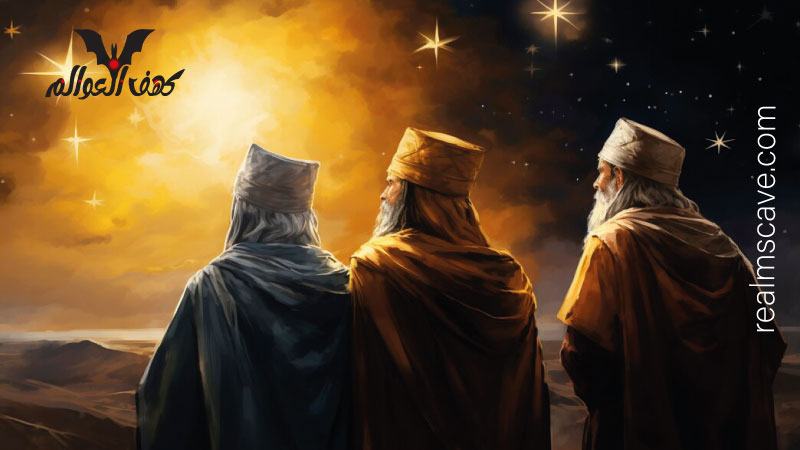mountain ق
In the vast and boundless dimensions of the Earth, tales have been told of a mountain that encompasses our world, just as the white of the eye holds its pupil. A mountain more distant than the peaks of Lemuria and deeper than Mumeiru. Ancient manuscripts and archives referred to it as Mount Qaf—Jabal al-Samaa (the Mountain of the Sky). Across the texts of the ancients and the civilizations of old, the accounts waver between fact and fiction regarding great mountains, some said to encircle the Earth, others standing tall at its center. What was found in most maps—both by Muslims and non-Muslims, Easterners and Westerners alike—was a common thread: the legend of the Great Mountain. Ancient books spoke of a land separate from ours, an oasis of secrets and desires. These stories captivated geographers and thinkers as they asked: Will its ancient secrets ever be revealed, or will they remain hidden? Is Mount Qaf just another peak among peaks, or does it carry within it one of Earth’s deepest mysteries? What lies beyond the Wall? Where is its location? And what is its connection to Dhul-Qarnayn and the nations of Gog and Magog? Could it be the barrier between our world and the world beyond—or simply a myth with no grounding in reality? In this mysterious documentary, we will journey through the hidden gateway behind the ancient mountains of Antarctica to explore an unknown realm—one where truth meets myth and reality blends with legend. Through the stories of the ancients, we will search for the truth behind the Great Mountain—the one said to surround the Earth and all upon it, like a collar around the neck. This is the story of Mount Qaf and the Land Beyond the Mountains. After watching the documentary The Seven Lands, you now have a broader vision to understand the tale of the Great Mountain. As always, the standard to distinguish truth from myth is the Divine Law—what God revealed to the prophets and messengers. Therefore, we must first define the topic across cultures, civilizations, and faith systems to gain a general picture before diving into comparisons and drawing conclusions. So we begin our journey to understand the mystery of Mount Qaf. Ancient texts from various civilizations speak of a colossal mountain that encircles the Earth, known in Arabic and Persian sources as Qaf. It is said to be made of green peridot, and some claim it is upon this mountain that the sky is upheld. Its height spans a journey of 500 years, and it stretches across the heavens and the seven layers of Earth. Each layer is surrounded by seas and mountains—seven of each. Imam al-Qurtubi (may Allah have mercy on him) mentioned in his tafsir that interpretations differed regarding Qaf. According to Ibn Zayd, Ikrimah, and al-Dahhak, it is a green peridot mountain that encircles the Earth—and that the color of the sky originates from it. The edges of the sky are said to be domed over it, and the peridot found among people is said to be fragments fallen from this mountain. There are also narrations attributed to Wahb ibn Munabbih that Dhul-Qarnayn once looked upon Mount Qaf and saw smaller mountains beneath it. He asked, "Who are you?" The mountain replied, "I am Qaf." When Dhul-Qarnayn inquired about the surrounding mountains, it said they were its roots—and that every city has a root from it. When God wills an earthquake, He commands the mountain to move one of its roots beneath the city. Al-Qazwini, in his book The Wonders of Creation and the Marvels of Creatures, also stated that Mount Qaf encircles the Earth and that the color of the sky stems from its green hue. He noted that all mountains on Earth are extensions or roots of Mount Qaf. If God wills to destroy a people, He commands an angel to move one of its roots. Ibn al-Wardi, in The Pearl of Wonders and the Unique of Marvels, wrote that beyond this mountain lies a land as white as silver, inhabited by angels gazing toward the Throne. Among them are those who have no knowledge of either Adam or Iblis. A narration attributed to Ibn Abbas (may Allah be pleased with them both) mentions Mount Qaf, though it has no authentic chain of transmission. Some early scholars claimed that Qaf, as mentioned in the Quran, refers to this encircling mountain. However, it is not appropriate to decisively affirm that, nor to deny it, as Qaf in the Quran is one of the disjointed letters—like Alif Lam Meem, Sad, or Ta Seen. Attributing interpretations to these letters without clear proof is a grave matter, for their true meaning is known only to God. Meanwhile, some scholars like Ibn Kathir (may Allah have mercy on him) doubted the mountain's existence, saying it may be among the Isra’iliyat (tales of the People of the Book) taken up by some Muslims. He said: "It was narrated from some of the early generations that Qaf is a mountain that surrounds the Earth. And this, by God, is among the fables of the Israelites." Yet he concluded: Such tales are not to be confirmed, nor outright denied. In Al-Durr al-Manthur, it's mentioned that the narrations about Mount Qaf are unreliable, having come through the Israelite traditions, which are known to contain gaps, alterations, and fabrications. From all this, we find that the reports from the ancients not only differ on the existence of Mount Qaf, but also on its nature and attributes. Some even claim Qaf to be one of the names of God. However, they mostly agreed on the concept of the Earth being flat and extended. Even Ibn Kathir, who regarded the tale of Mount Qaf as a fable, said in his tafsir: “And the Earth—how it has been spread out, leveled, and prepared—it is laid flat by the creation of God.” It is worth noting that the first to claim the Earth is spherical were the idol-worshipping pagans of Greece, foremost among them Pythagoras, the founder of esoteric Gnosticism. To examine the matter and discern fact from myth, let us turn to ancient maps, both from Islamic tradition and beyond, to make a clearer distinction. We begin with the maps of Al-Idrisi, considered among the most accurate of the Middle Ages. Al-Idrisi—Abu Abdullah Muhammad ibn Muhammad al-Idrisi al-Hashemi al-Qurashi—was one of the greatest geographers in history and is counted among the founders of the science of geography. His maps were used in all European Renaissance explorations, serving as beacons to uncover the unknown lands and oceans. By the grace of God, a preserved map of Al-Idrisi—kept like a treasure in the Bodleian Library of Oxford University in Britain—was shown to me by someone who lived there. He told me: “My friend Andoria, true knowledge is reserved for the elite—it is not made available to the flock. Let those who understand, understand, and let those who laugh, laugh. These maps are now public only because people have become the walking dead—there’s no use hiding them anymore.” You said: Secrecy... for no matter how much evidence you present, people will only believe what they see on the Dajjal’s screens. The first map is a prototype that gathered the known regions within a surrounding ocean, encircled by the mountains of Antarctica. Behind those mountains lies Mount Qaf, surrounding them from every direction—east, west, south, and north. In the second version of the map, more details of our land appear clearly, including the specific location of Gog and Magog at the very edge of the earth. Once again, the encircling ocean is shown, which itself is surrounded by a massive mountain from all sides. But the question arises: why is this map inverted? This inversion reveals one of the West’s crimes against Islamic sciences—a deep falsification falsely attributed to Al-Idrisi, of which he is innocent. If you ask Muslims today, they’ll say he was the first to confirm the Earth’s spherical shape. But this is a lie and a distortion. Here’s the proof: In Nuzhat al-Mushtaq fi Ikhtiraq al-Afaq, one of Al-Idrisi’s most famous books—often quoted by YouTube parrots and TV celebrities as evidence of Earth’s roundness and gravity—if Al-Idrisi truly claimed the Earth is a sphere, then why do his maps contradict this claim? Some may say it’s because these are flat projections made to gather the regions and make them clearer. Others will argue that in pages 7 and 8 of his famous book, he clearly states that the Earth is spherical. Yet the rest of the pages speak of matters that contradict that claim. Thirdly, when examining the map, one inevitably wonders: what is the massive mountain surrounding the entire Earth beyond the ocean waters? He referred to these waters as the "encircling ocean of the Earth," and he spoke of a great mountain that encompasses the Earth and its seas





إرسال التعليق